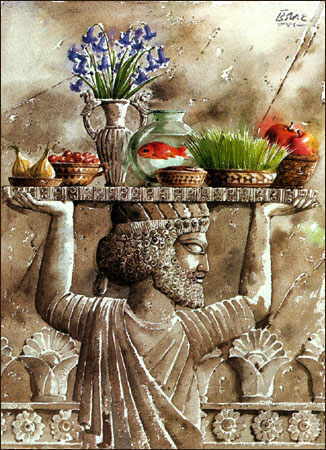 Provenance is unknown. According to Iranian mythology, on this day he was buried a hero Siyavush killed by Afrasiyab Turanians. This legend is mentioned in the Avesta (Yasht Ard, 17:42, "Avesta" in Russian translation (1861-1996). St. Petersburg. "Summer Garden", 1998., P. 370). More detail it is described in the "Shah Namah" Ferdowsi. "From the extant sources, it appears that the day of the funeral Siyavush was called" Nowruz ", and is celebrated as a holiday ..." (A. Nabiev, "Novruz." Baku, "Yazichi", 1990. P. 3).
Provenance is unknown. According to Iranian mythology, on this day he was buried a hero Siyavush killed by Afrasiyab Turanians. This legend is mentioned in the Avesta (Yasht Ard, 17:42, "Avesta" in Russian translation (1861-1996). St. Petersburg. "Summer Garden", 1998., P. 370). More detail it is described in the "Shah Namah" Ferdowsi. "From the extant sources, it appears that the day of the funeral Siyavush was called" Nowruz ", and is celebrated as a holiday ..." (A. Nabiev, "Novruz." Baku, "Yazichi", 1990. P. 3).
We know that this holiday is contained animistic elements. On the day of Nowruz ancient Indo-Aryans worshiped the so-called "Fravashi" - the spirits of deceased ancestors. This custom was later borrowed by Zoroastrianism, which became the official religion of Iran. One of the seven major holidays Zoroastrians "coincided with the end of winter and usher in the spring and passed on the feast of remembrance of the souls of ancestors (Nowruz). He fell on the night before the vernal equinox "(EA Doroshenko." Zoroastrians in Iran. "Moscow," Nauka ", 1982., P. 69).
British scientist M. Boyce pointed out that in addition to all this, in Zoroastrianism, the holiday was dedicated directly to the fire, which the ancients believed zoroastristy vitality and worshiped him. "Zoroaster timed this holiday for the spring equinox, using apparently the ancient celebration of spring, which is devoted to Asha Vahishta (" Best of righteousness "), and fire. This festival heralds the onset of ahurovskogo time of year - summer - and marks the defeat of the annual Evil Spirit. In Zoroastrian traditions, at noon a new day welcomed the return of the spirit out of the ground Rapitvina midday, carrying heat and light. After that, the spirit Rapitvina daily worship in the allotted time, midday, which is now called "Rapitva" and urged prayers Asha Vahishta throughout the summer "(M. Boyce," Zoroastrians. Beliefs and customs. "Moscow," Nauka ", 1987 , page 45).
Initiation of the fire festival in the later Zoroastrian tradition, no doubt. On the day of Nowruz More Achaemenid and Sassanid with periods in the temples of worship were made to fire. Iran's rulers of the period took on this day presents from the conquered peoples (M. Boyce, "Zoroastrians. Beliefs and customs." Moscow, "Nauka", 1987, page 71). Fires burned everywhere, from the highest places on the roofs of houses and ending with candles on celebratory table (Doroshenko. EA Zoroastrians in Iran. Moscow, "Nauka", 1982, page 72). At the present time, these practices have been partially preserved. So in some regions of Azerbaijan "on all the hills fueled the fires" ("Nowruz. Sheylyar. Citing oyun BR tamashalary." Baku, "Yazichi", 1989, p 106). People stand in a circle around the fire and sing folk songs ("Nowruz. Sheylyar. Citing oyun BR tamashalary." Baku, "Yazichi", 1989, pp. 106, 115). Candles are also the attributes of the banquet tables in the day, "Nowruz", and days preceding it (making him start a few weeks before the holiday) ("Nowruz. Sheylyar. Citing oyun BR tamashalary." Baku, "Yazichi", 1989, page 115) .
Similar traditions are preserved in Iran and Central Asia. For example, Negmat AN writes that the inhabitants of the towns of Samarkand and is highly offensive celebrate the last Tuesday before the New Year on the Persian calendar (Nowruz) ("Musyalman bayramlary." Baki "Azyarbadzhan", 1993, page 38) . After sunset, the people fueling the fires, sing songs, play the national instrument. To the sounds of a drum, they organize a torchlight procession to the outskirts of the river and there organize the festival. They jump over bonfires divorced them and bathe in the river. Wealthier Tajiks in the day to organize joint meals for low-income citizens. Jumping over bonfires, they wish on the nature of an abundant harvest, and are looking for protection from evil spirits and genies. Jump over the fire, even women with babies hoping that by doing so they have during the year will be spared the misfortunes and miseries.
Preserved at the present time, and other attributes of the Zoroastrian holiday. For example, Zoroastrians vessels filled seeds of wheat or barley, filled them with water, and then, when they germinate, associated them home and put in a special place (Doroshenko. EA Zoroastrians in Iran. Moscow, "Nauka", 1982, page 72). Similarly, at the present time is left on the germination of seeds of cereals for the holiday in Azerbaijan, Iran and Central Asia ("Nowruz. Sheylyar. Citing oyun BR tamashalary." Baku, "Yazichi", 1989, page 115). On the festive table Zoroastrians put the eggs - a symbol of the origin of life and the sweetness of specific [3, c. 72]. They are present at the festive table and now ("Nowruz. Sheylyar. Citing oyun BR tamashalary." Baku, "Yazichi", 1989, page 115).
As can be seen from the above brief review of the nature and history of the origin of the Novruz holiday, it has a pre-Islamic origin, and his philosophy, and ritual do not have to do with Islam. There is no doubt that in addition to Iran's national components of this holiday were introduced and the Turkic pagan rites. The fact that in ancient times the Turks (Turanians), and the Iranians have the most direct cultural contacts, which continues to this day. Information about this are contained in the Avesta (Yasht Ard, 17:38). Moreover, the historical roots of (pagan and Zoroastrian past), and natural-philosophical essence of this holiday is in contradiction with Islam, the essence of which lies in the strict monotheism and the rejection of worship of natural forces.
The classical Islamic teaching does not tend to compromise with the pagan heritage of the past. And this manifests itself as an uncompromising stand with the pagan traditions of the Arabs themselves, and in the case of non-Arabs. Thus, the syncretism of classical Islamic teachings have no place. This assertion is supported by numerous examples from Islamic history and primary sources, including on the issue of compatibility of pagan holidays and customs of Islam. In the most authoritative collections of hadith of the Prophet Muhammad clearly given to understand that the Islamic world does not accept the pre-Islamic era celebrations. The most typical in this regard, the following hadith:
Narrated by Anas, may Allah be pleased with him: "When the Prophet, sallallaahu alayhi wa sallam, came to Medina, where people celebrated two holidays. Those days were days of joy and fun. Prophet, sallallaahu alayhi wa sallam, said:" A what a day (in which their essence)? "He replied:" At the time of Jahiliyyah (paganism), we had fun in those days. "The Prophet, sallallaahu alayhi wa sallam, replied:" Allah you replaced those two holidays for two more useful holiday - it's Eid and the Eid. "(Abu Dawood." Salat "245, (1134), NASA," Idayn "1, (3, 179)).
Attention is drawn to the fact that the prophet did not even attempt to adjust the two pagan rituals of the holiday under the new religion which he preached. He immediately canceled them and said that instead of people of Medina will celebrate the very essence of the other parties, which, in the words of the prophet, will bring them more benefits.
Another example of an uncompromising struggle of the Prophet with remnants of pagan traditions is the following hadith: Thabit ibn al-Dahhak said: "Once a man vowed to kill the sacrificial camel Boigny, and asked about the opinion of the prophet. He said: "He stood there on the site of some pagan idol worshiped by the people?" He replied, "No". The Prophet again said, "And if there were any festivities idolaters?" People said, 'No, do not pass. " Then Muhammad said: "Fulfill your vow, because you should not perform the vow given to God in disobedience, as well as what does not own the son of Adam '" (Abu Dawood, 13 313).
It follows from this hadith, the Prophet forbade even to make the Islamic rituals and rites of sacrifice to the pagan places of similar gatherings of the past, fearing that people can not help remember these places of past traditions and begin to devote their rites of false gods.
From the work of all four recognized scholars orthodox maskhabov Islam (Hanafi, Shafi'i, Maliki, Hanbali), we can conclude that the Islamic world did not recognize any holidays besides Idayna (2 holiday - Lent and Sacrifice), and does not allow any of the alternatives in the festivities religion in addition to these 2 .. In the books of fiqh all sharia rules and regulations are only in the Idayna (Zuhayli. V. "Islam fikhi ansiklopedisi" c. 2. Istanbul, "Feza yayincilik" 1994, p. 452-479). In the Koran, according to authoritative Muslim interpreters, in Sura 22, verses 28 and 29 are referred to the rites of sacrifice feast (Ibn Kesir. "Hadislerle Kur'ani-Kerim tefsiri", c. 10. Istanbul, "Sagri yayinleri", 1990, p. 5445).
Judging by the following saying of the Prophet Muhammad - "God will curse anyone who supports those who introduces an innovation in religion" (Muslim, hells, 43 (1978), NASA, Dahaya 34, (7, 232)) - it can be concluded that point of view of Islamic teachings and rituals of the introduction of non-Islamic holidays origins in religion are not allowed, although such attempts, by the example of Nowruz in recorded history and highlights. This phenomenon occurs due to the fact that some people are trying to adapt them to the usual national traditions of their people under the Islamic faith, which is in essence a supranational. For example, it says in the book "The Muslim holidays": "Persian-speaking peoples celebrated Nowruz with special solemnity, and then it gave the Islamic holiday of color" ("Musyalman bayramlary." Baki "Azyarbadzhan", 1993, p. 36).
In conclusion, it should be noted that all the attempts of some people imagine Nowruz, or other non-Islamic holidays as Muslims are deprived of any scientific or historical basis. In addition, pursuant to the provisions of the Islamic faith, in this article, make it categorically zapreschatsya. Such attempts have had a negative impact on the whole idea of the universality of the Islamic religion, its universality and globality are trying to represent this world religion in the narrow framework of their national and tribal beliefs.

 |
 |
|||
History of Nowruz




